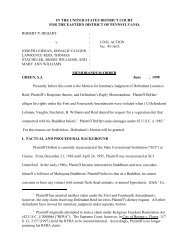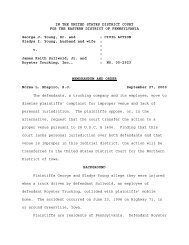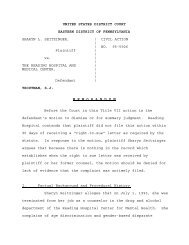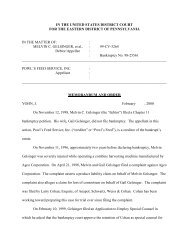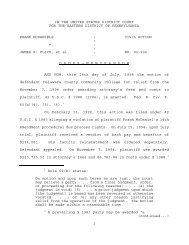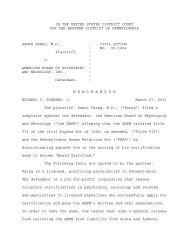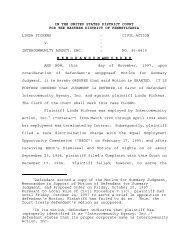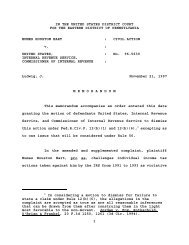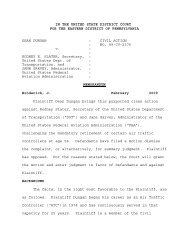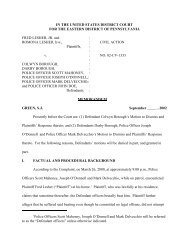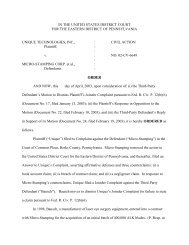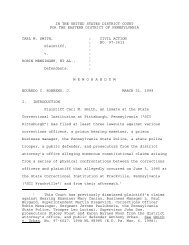Counts 1 and 2 of the complaint set forth the claims of plaintiff Puscar
Counts 1 and 2 of the complaint set forth the claims of plaintiff Puscar
Counts 1 and 2 of the complaint set forth the claims of plaintiff Puscar
You also want an ePaper? Increase the reach of your titles
YUMPU automatically turns print PDFs into web optimized ePapers that Google loves.
IN THE UNITED STATES DISTRICT COURT<br />
FOR THE EASTERN DISTRICT OF PENNSYLVANIA<br />
MICHAEL P. PUSCAR <strong>and</strong> JOHN :<br />
J. PARDINI, :<br />
Plaintiffs, : CIVIL ACTION<br />
:<br />
v. : No. 96-CV-8442<br />
:<br />
HALE PRODUCTS, INC., :<br />
Defendant. :<br />
MEMORANDUM ORDER<br />
Presently before <strong>the</strong> Court are<br />
defendant's motion for summary judgment <strong>of</strong><br />
Count III (Age Discrimination in Employment<br />
Act claim) <strong>and</strong> motion to dismiss Count IV<br />
(Pennsylvania Human Relations Act claim) <strong>of</strong><br />
<strong>plaintiff</strong> Pardini's <strong>complaint</strong>. 1<br />
Upon<br />
consideration <strong>of</strong> defendant's motions <strong>and</strong><br />
<strong>plaintiff</strong> John J. Pardini's (“Pardini”)<br />
1<br />
<strong>Counts</strong> 1 <strong>and</strong> 2 <strong>of</strong> <strong>the</strong> <strong>complaint</strong> <strong>set</strong><br />
<strong>forth</strong> <strong>the</strong> <strong>claims</strong> <strong>of</strong> <strong>plaintiff</strong> <strong>Puscar</strong>; said<br />
<strong>claims</strong> are not <strong>the</strong> subject <strong>of</strong> <strong>the</strong> pending<br />
motions.
esponse <strong>the</strong>reto, defendant's motions will<br />
be denied.<br />
I. FACTS<br />
The material facts are not in dispute.<br />
Pardini was employed by defendant Hale<br />
Products Inc., from on or about May 26,<br />
1969, through August 23, 1993. On August<br />
23, 1993, his position as Plant Manager for<br />
defendant's Equipment Division was<br />
terminated; his job responsibilities were<br />
reassigned to a younger employee <strong>and</strong><br />
<strong>the</strong>reafter defendant failed to rehire him.<br />
Pardini timely filed a charge with <strong>the</strong><br />
Equal Employment Opportunity Commission<br />
("EEOC") claiming that <strong>the</strong> personnel<br />
decisions were made because <strong>of</strong> his age.<br />
On September 28, 1995, Pardini signed a<br />
2
eturn receipt for certified mail which<br />
contained a form <strong>of</strong> “right-to-sue letter.”<br />
The EEOC did not send a copy <strong>of</strong> <strong>the</strong> “rightto-sue<br />
letter” to Pardini’s counsel. The<br />
EEOC acknowledges that <strong>the</strong> “right-to-sue<br />
letter” was not intended but was<br />
inadvertently sent to Pardini as <strong>the</strong> result<br />
<strong>of</strong> a clerical error by <strong>the</strong> EEOC. 2<br />
After<br />
2<br />
In his affidavit, William D. Cook,<br />
Enforcement Manager for <strong>the</strong> Philadelphia<br />
District Office <strong>of</strong> <strong>the</strong> EEOC, states that<br />
<strong>the</strong> September 28, 1996 “right-to-sue<br />
letter” was issued as a result <strong>of</strong> clerical<br />
error. Mr. Cook states that Ms. Pinkey<br />
Lucas, <strong>the</strong> EEOC Investigator assigned to<br />
Pardini’s charge, informed him that “she<br />
had been unaware <strong>of</strong> <strong>the</strong> September 28, 1995<br />
Dismissal Notice <strong>and</strong> continued to process<br />
<strong>the</strong> Pardini charge <strong>the</strong>reafter as if it was<br />
an open charge.”<br />
Mr. Cook concludes “that <strong>the</strong> September<br />
28, 1995 Dismissal <strong>and</strong> Notice <strong>of</strong> Rights for<br />
Charge 170941121, even if actually received<br />
by all parties, was issued in error.<br />
Clearly, staff from both <strong>the</strong> Enforcement<br />
Unit <strong>and</strong> <strong>the</strong> Legal Unit continued to<br />
3
sending <strong>the</strong> September 28, 1995 “right-tosue<br />
letter” to Pardini, <strong>the</strong> EEOC continued<br />
to investigate <strong>and</strong> to process Pardini’s<br />
charge. Pardini’s counsel continued to<br />
communicate with <strong>the</strong> EEOC <strong>and</strong> provide it<br />
with information regarding his charge <strong>of</strong><br />
discrimination by defendant.<br />
On December 16, 1996, after completion<br />
<strong>of</strong> <strong>the</strong> EEOC investigation, <strong>the</strong> EEOC sent<br />
Pardini <strong>and</strong> his counsel a right-to-sue<br />
letter. On December 18, 1996, Pardini<br />
filed his <strong>complaint</strong>. In his <strong>complaint</strong>,<br />
process that charge <strong>the</strong>reafter in<br />
conjunction with <strong>the</strong> related <strong>Puscar</strong> charge<br />
<strong>and</strong> to treat both charges in <strong>the</strong> same<br />
manner, i.e., as open charges.” Mr. Cook<br />
“recommended to <strong>the</strong> District Director that<br />
she issue a Notice <strong>of</strong> Reconsideration <strong>and</strong><br />
Notice <strong>of</strong> Rescinding concerning <strong>the</strong><br />
September 28, 1995 Dismissal <strong>and</strong> Notice <strong>of</strong><br />
Rights” for Pardini’s charge.<br />
4
Pardini alleges that he was terminated <strong>and</strong><br />
not rehired by defendant because <strong>of</strong> his<br />
age. Pardini also contends that defendant<br />
fired him in reckless disregard <strong>of</strong> his<br />
rights under <strong>the</strong> Age Discrimination in<br />
Employment Act, 42 U.S.C. § 621 et seq.,<br />
<strong>and</strong> <strong>the</strong> Pennsylvania Human Relations Act,<br />
42 Pa. C.S.A. § 951 et seq.<br />
II. DISCUSSION<br />
Under Rule 56(c), summary "judgment<br />
sought shall be rendered <strong>forth</strong>with if <strong>the</strong><br />
pleadings, depositions, answers to<br />
interrogatories, <strong>and</strong> admissions on file,<br />
toge<strong>the</strong>r with affidavits, if any, show that<br />
<strong>the</strong>re is no genuine issue as to any<br />
material fact <strong>and</strong> that <strong>the</strong> moving party is<br />
entitled to a judgment as a matter <strong>of</strong> law."<br />
5
Fed. R. Civ. P. 56(c); Celotex Corp. v.<br />
Catrett, 477 U.S. 317, 106 S. Ct. 2548<br />
(1986). All <strong>of</strong> <strong>the</strong> facts must be viewed in<br />
<strong>the</strong> light most favorable to <strong>the</strong> non-moving<br />
party <strong>and</strong> all reasonable inferences must be<br />
drawn in favor <strong>of</strong> <strong>the</strong> non-moving party.<br />
The facts material to this motion are not<br />
in dispute; however, defendant is not<br />
entitled to judgment as a matter <strong>of</strong> law.<br />
The Age Discrimination in Employment Act<br />
states, in pertinent part,<br />
If a charge filed with <strong>the</strong> Commission<br />
[<strong>the</strong> EEOC] under this chapter is<br />
dismissed or <strong>the</strong> proceedings <strong>of</strong> <strong>the</strong><br />
Commission are o<strong>the</strong>rwise terminated<br />
by <strong>the</strong> Commission, <strong>the</strong> Commission<br />
shall notify <strong>the</strong> person aggrieved. A<br />
civil action may be brought under<br />
this section by a person defined in<br />
section 630(a) <strong>of</strong> this title against<br />
<strong>the</strong> respondent named in <strong>the</strong> charge<br />
within 90 days after <strong>the</strong> date <strong>of</strong> <strong>the</strong><br />
receipt <strong>of</strong> such notice.<br />
6
29 U.S.C. § 626(e). The ninety day period<br />
acts as a statue <strong>of</strong> limitations in which to<br />
bring <strong>the</strong> <strong>complaint</strong> in federal court. See<br />
Sperling v. H<strong>of</strong>fmann-La Roche, Inc., 24<br />
F.3d 463, 464 n.1 (3d Cir. 1994). The<br />
ninety day period begins to run when <strong>the</strong><br />
EEOC notifies <strong>the</strong> charging party <strong>of</strong> his<br />
right to sue. Said notice is authorized<br />
only after <strong>the</strong> Commission has in fact<br />
dismissed <strong>the</strong> complainant’s charges or in<br />
fact terminated its proceedings. 29 U.S.C.<br />
§ 626(e). Although <strong>the</strong> EEOC sent Pardini<br />
<strong>the</strong> September 28, 1995 “right-to-sue<br />
letter,” it did not dismiss his charge nor<br />
did it terminate its investigation into his<br />
charge. Defendant has not cited any<br />
authority which holds that <strong>the</strong> ninety day<br />
7
period begins to run when <strong>the</strong> EEOC, as <strong>the</strong><br />
result <strong>of</strong> a clerical error, unintentionally<br />
issues a “right-to-sue letter” to <strong>the</strong><br />
charging party. Only after <strong>the</strong> EEOC<br />
completed its investigation <strong>and</strong> issued <strong>the</strong><br />
December 16, 1996 right-to-sue letter did<br />
<strong>the</strong> ninety day period start to run.<br />
Accordingly, Pardini’s <strong>complaint</strong> is not<br />
time barred because no legal consequence<br />
attached to <strong>the</strong> September 28, 1995 letter.<br />
Moreover, even if I assume, as defendant<br />
argues, that <strong>the</strong> ninety day period began to<br />
run upon Pardini’s receipt <strong>of</strong> <strong>the</strong><br />
unintended September 28, 1995 “right-to-sue<br />
letter,” <strong>the</strong> manner in which <strong>the</strong> EEOC<br />
h<strong>and</strong>led Pardini’s charge effectively tolled<br />
<strong>the</strong> ninety day period. The ninety day<br />
8
period "is subject to waiver, estoppel <strong>and</strong><br />
equitable tolling." Schafer v. Board <strong>of</strong><br />
Public Education, 903 F.2d 243, 251 (3d<br />
Cir. 1990)(quoting Zipes v. Trans World<br />
Airlines Inc., 455 U.S. 385, 393, 102 S.<br />
Ct. 1127, 1132 (1982)). The Third Circuit<br />
has stated that <strong>the</strong> ninety day period in<br />
which a <strong>complaint</strong> is to be filed may be<br />
tolled "(1) where <strong>the</strong> defendant has<br />
actively misled <strong>the</strong> <strong>plaintiff</strong> respecting<br />
<strong>the</strong> <strong>plaintiff</strong>'s cause <strong>of</strong> action; (2) where<br />
<strong>the</strong> <strong>plaintiff</strong> in some extraordinary way has<br />
been prevented from asserting his or her<br />
rights; or (3) where <strong>the</strong> <strong>plaintiff</strong> has<br />
timely asserted his or her rights<br />
mistakenly in <strong>the</strong> wrong forum." Oshiver v.<br />
Levin, Fishbein, Sedran & Berman, 38 F.3d<br />
9
1380, 1387 (3d Cir. 1994). However, this<br />
list is not all inclusive. The EEOC’s<br />
failure to abide by its procedures is<br />
sufficient reason to equitably toll <strong>the</strong><br />
ninety day period; particularly, where as<br />
here, <strong>plaintiff</strong> continued to assert his<br />
rights before <strong>the</strong> EEOC. See Anderson v.<br />
Unisys Corp., 47 F.3d 302, 306-7 (8th Cir.<br />
1995), cert. denied, 116 S. Ct. 299 (1995). 3<br />
Accordingly, defendant’s motion for summary<br />
judgment <strong>of</strong> Count III will be denied.<br />
Additionally, this Court will continue to<br />
exercise supplemental jurisdiction over<br />
3<br />
Defendant argues that <strong>the</strong> EEOC is<br />
without authority to reconsider on its own<br />
motion. However, defendant does not<br />
address <strong>the</strong> EEOC’s power to correct a<br />
“right-to-sue letter” which was issued<br />
through clerical error. Nei<strong>the</strong>r statutory<br />
nor regulatory language prevents <strong>the</strong> EEOC’s<br />
from correcting a clerical error.<br />
10
Pardini’s Pennsylvania Human Relations Act<br />
claim. 28 U.S.C. § 1367(a). Defendant’s<br />
motion to dismiss Count IV will also be<br />
denied<br />
An appropriate order follows.<br />
11
IN THE UNITED STATES DISTRICT COURT<br />
FOR THE EASTERN DISTRICT OF PENNSYLVANIA<br />
MICHAEL P. PUSCAR <strong>and</strong> JOHN :<br />
J. PARDINI, :<br />
Plaintiffs, : CIVIL ACTION<br />
:<br />
v. : No. 96-CV-8442<br />
:<br />
HALE PRODUCTS, INC., :<br />
Defendant. :<br />
ORDER<br />
AND NOW, this 3rd day <strong>of</strong> September,<br />
1997, upon consideration <strong>of</strong> defendant's<br />
motions <strong>and</strong> <strong>plaintiff</strong> Pardini's response<br />
<strong>the</strong>reto, IT IS HEREBY ORDERED that<br />
defendant's Motion for Summary Judgment <strong>of</strong><br />
Count III <strong>of</strong> <strong>plaintiff</strong> <strong>complaint</strong> <strong>and</strong> Motion<br />
to Dismiss Count IV <strong>of</strong> <strong>plaintiff</strong>’s<br />
<strong>complaint</strong> are DENIED.<br />
BY THE COURT:
__________________________<br />
CLIFFORD SCOTT GREEN,<br />
S.J.<br />
13



